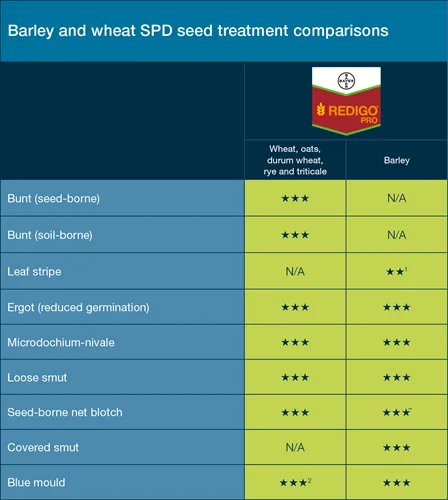

Redigo Pro
Ensure sound establishment in all varieties of wheat and barley – both winter and spring – with Redigo Pro (active substances: prothioconazole and tebuconazole).
Product details
Ensure sound establishment in all varieties of wheat and barley – both winter and spring – with Redigo Pro (active substances: prothioconazole and tebuconazole). Gain a healthy crop you can build on for high yield potential, yet with a low application dose. You can also use Redigo Pro on durum wheat, winter and spring oats, rye and triticale.
With two advanced actives that work together inside germinating seedlings, Redigo Pro controls all main seed- and soil-borne wheat and barley diseases.

Kick off your season-long strategy with Redigo Pro. To gain the maximum benefit, check out the recommended programmes below. Use follow-up broad-spectrum herbicides such as Liberator and SiltraXpro or Fandango fungicides. For effective control of Fusarium ear diseases, and ultimately to minimise mycotoxins, use in a programme with a foliar fungicide such as Proline275 (prothioconazole).
Spring barley

Winter barley

Last year’s outbreak of loose smut in winter barley treated with various different fungicidal seed treatments does not appear to have been caused by resistance developing to the active ingredients in the seed treatments.
Initial laboratory studies by Bayer on barley seed stocks used in outbreak fields and confirmed by seed testing prior to the lab studies as infected with loose smut, have shown no evidence of resistance. However, we cannot exclude sensitivity changes.

The Anderson's crop area forecast for 2020 is suggesting that the spring barley area could be 6.4% up on 2019, at 761,000 hectares. With more growers looking to plant spring barley for distilling or brewing, they need to do everything possible to make a success of the crop.
“The main challenge with growing spring barley is achieving the quality,” says John Murrie, Agrochemical Manager at Scotgrain Agriculture, “It’s a premium product, so there are a lot of quality parameters the crop needs to meet, like soundness of the grain and 98% or above germination.”
In spite of these potential challenges, there are also a number of advantages to growing spring barley in the UK. Simon Hobbs, Seed Manager – North Anglia at Agrii notes: “The crop operates as a good entry for OSR in England, and it’ll compete with spring germinating black-grass better than spring wheat, which is a key attribute for growers who have changed crop rotations because of it. Cost of production is also lower than for winter crops and potential returns greater with the correct management.”
The situation is similar in Scotland, too, as Mr Murrie explains: “In Scotland, spring barley fits in well with rotations and with the growing season – growers are able to sow it in March and April very successfully, and then harvest in August and September before the bad weather hits. It’s also a lower input crop compared with winter cereals, and is a good margin earner.”
Here are five tips to help you win with spring barley:
Attention to detail –
With such high demands on the quality of the crop, it’s crucial that growers don’t overlook any detail. “You’ve got to make sure you have the correct soil, the correct pH, the correct fertiliser,” Mr Murrie says, “You can’t cut corners, because if the crop isn’t up to the right standard, it’s not going to work for distilling.”
Prepare your seedbed –
“Spring barley doesn’t like any compaction, so the seed bed needs to be good and even,” Mr Hobbs says, “The sooner you prepare the seedbed the better, depending on soil type, and don’t leave it too rough. In the spring, if black-grass is a threat, you don’t want to be cultivating in front of your drill – minimal soil disturbance when drilling is the best way to avoid encouraging a new flush of black-grass”.
Watch the nitrogen –
When it comes to spring barley, applying nitrogen is a different proposition to winter barley. “With winter barley you can generally apply as much nitrogen as you like within NVZ (nitrate-vulnerable zone) regulations,” Mr Murrie points out, “With spring barley, you have to look at previous cropping to ensure you don’t apply too much. Obviously if you’re growing for distilling, it’s slightly different than if you’re growing for brewing, so in terms of how much nitrogen you’re applying, you need to look at the market you’re growing for.”
Don’t skimp on the seed treatment –
“You want an appropriate treatment that’s going to cover as many bases as possible in terms of disease,” Mr Murrie says, “If you spend the money putting the crop in the ground and then it doesn’t come through, you’ve wasted a lot of money. So a good-quality seed dressing at the top end of control for all the main seed-borne diseases is crucial.”
Timing is everything –
“If you’re somewhere like Norfolk, which has light lands, you might want to drill pre-Christmas, because you need to get a better developed root system early ahead of any potential drought. Soil moisture on light land disappears quickly if you get a dry spring,” explains Mr Hobbs, “While if you’re on heavy land, you’re not going to be able to drill until the land dries out, which may be at the end of February or even the end of March – any later and yields will suffer. So it’s important on heavy soils to give yourself the best opportunity to drill early by utilising early autumn cultivations or by the use of an overwinter cover crop to improve seedbed conditions. Always adjust your seed rates according to drilling date and seed bed conditions as well, a typical range being 300 to 375 seeds per square metre.”
After winter barley, growers will have to become accustomed to a shorter growing season as well as the increased number of quality parameters. But with a robust growing strategy and planning ahead, growers can make the most of the crop and yield substantial returns.
“Redigo Pro lets us deliver”
Redigo Pro has quickly become the standard in single-purpose crop protection. Discover how it dependably enables top growers like Jeremy Fulcher from Essex to deliver high-quality milling wheat for large export contracts.
Jeremy Fulcher, Kings Barn Farm.